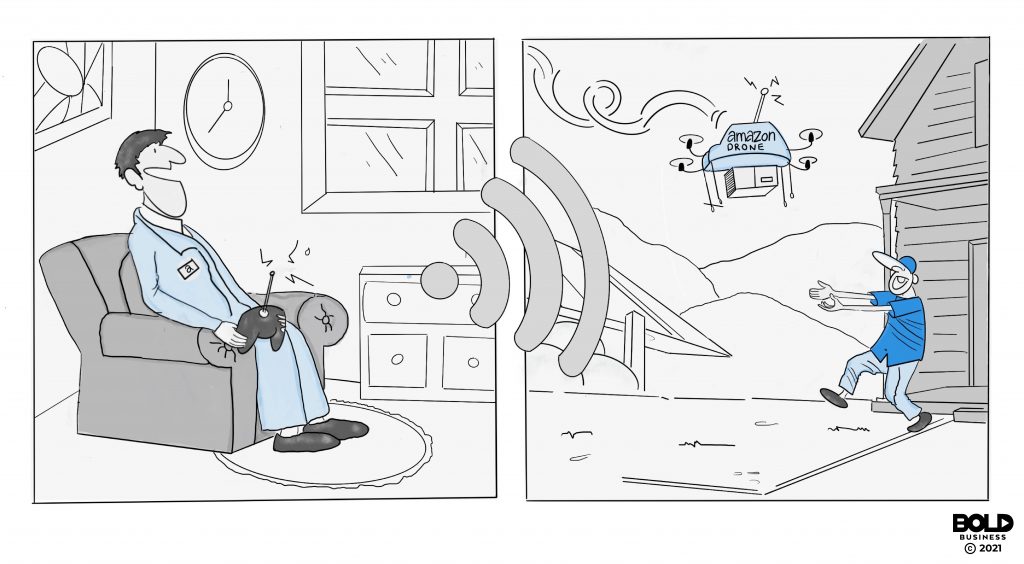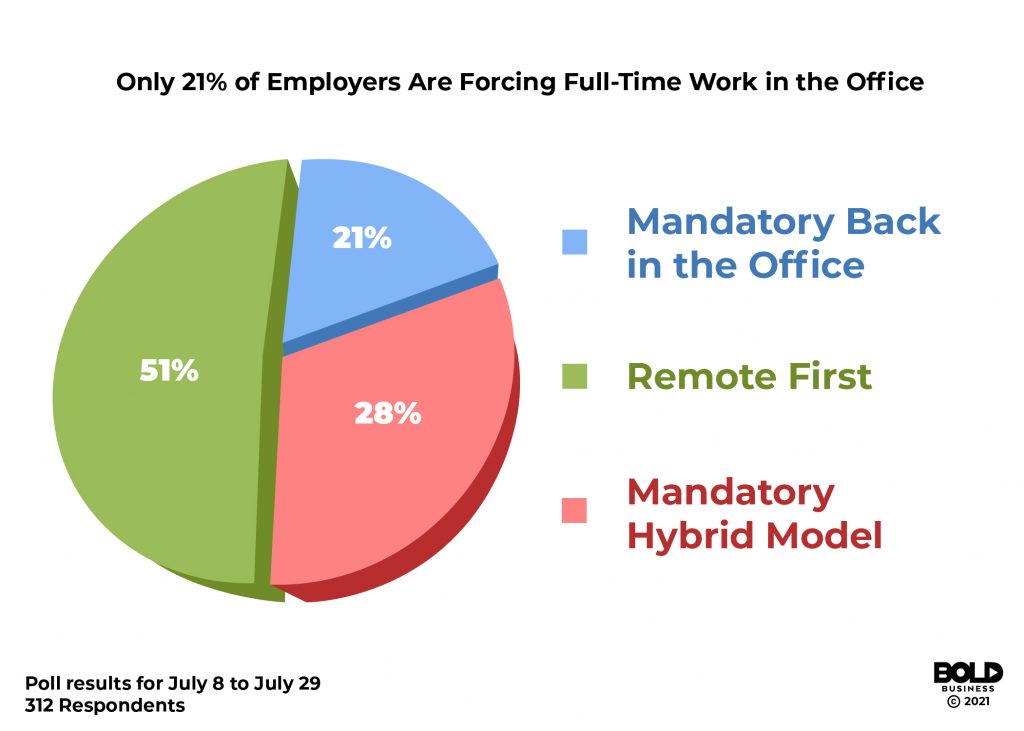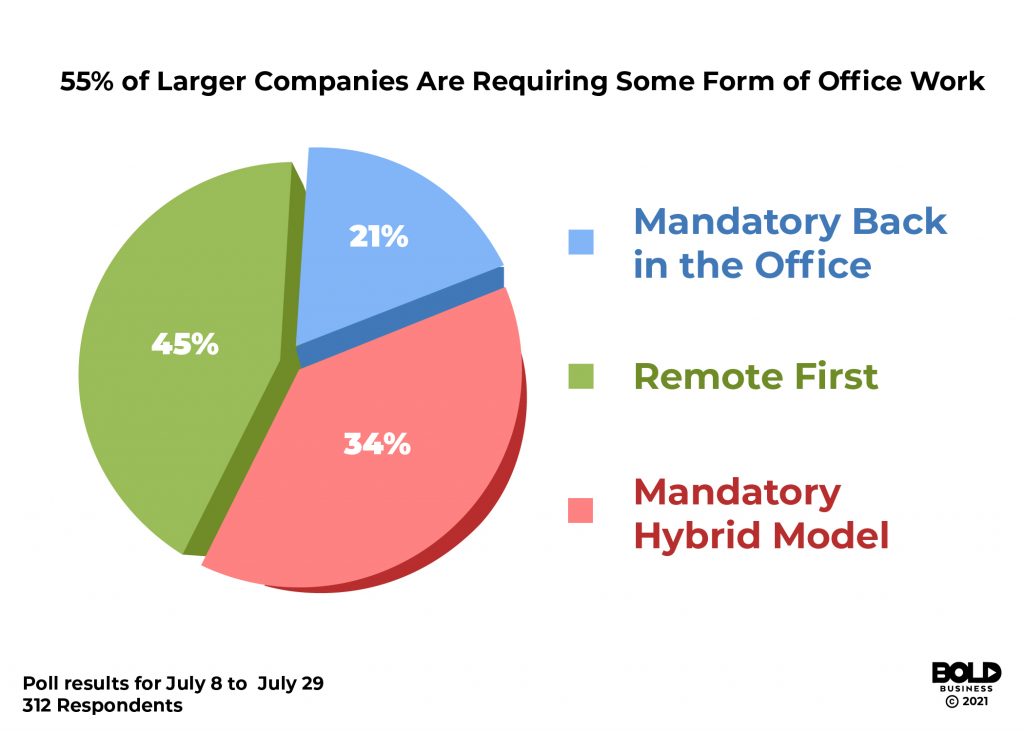TLDR:
- According to a Bold Business survey, 93% of employees want to work from home in some capacity
- Work-from-anywhere is becoming institutionalized, Companies fighting it are on the wrong side of the future
- The observational metrics used to monitor employees in the office are inferior to the system-generated metrics used for employees working from home
- JPMorgan boss Jamie Dimon and others think office culture is company culture–they’re wrong
- Common sense will prevail, with 80% of companies already promoting work-from-home or a hybrid model
The era of working from anywhere is upon us, and anyone trying to put workers back into cubicles is on the wrong side of the future. According to an exclusive 2021 remote work survey conducted by Bold Business during July, of 312 respondents, 93% preferred to work remotely in some capacity over working full-time in an office setting. In addition, almost 70% preferred full-time remote work over working full-time in the office or a hybrid model of remote work and office work.
That means employers who want their workforce back in the office full-time–and there are quite a few–are fighting against the tide, and they will lose out to companies who offer flexibility in lieu of mandatory office time. As I spoke of in the Come to Me Economy article, it’s the natural evolution of work. We’ve gone from farms to factories to cubicles, and now working from anywhere is here!
Big companies–as per Bold’s 2021 remote work survey, that’s companies with over 10,000 employees–are less flexible compared to smaller companies, with 55% requiring their employees to do some form of in-office work (either full-time or hybrid part-time office/part-time work-from-home).
Smaller companies (under 10,001 employees) are more amenable to remote work, with only 21% requiring employees to come back to the office full-time. It’s worth noting that, with smaller companies functioning as job creators and providing the vast majority of job growth, their policies provide a glimpse at what the future likely holds for workforce policies in general.
[Read the full 2021 remote work survey questions here.]

What do these numbers mean for companies big and small? As a Wall Street Journal story on Work-From-Anywhere perks giving some businesses a hiring edge points out, employees value remote-work opportunities.
Here is a real-life example: recently, my company was looking to fill a senior support role that required a high in-demand skill set. We identified numerous candidates. The one we wanted to hire advised us that she had numerous other opportunities, but she said an important differentiator for her would be if her position was classified as WFH—she would only take the position if so. Of course, we embraced WFH over a year ago, and she decided to join us over other good offers. The notion of Come-to-Me Employment, where work comes to workers instead of vice versa, won out!
What of those companies who refuse to accept the new reality of Come-to-Me Employment? To quote a recent Bloomberg article, a “great resignation” may be coming for the dinosaur companies who cling to the office-based workforce policy model. “Cube” life is on it’s way down!

The Superiority of System-Generated Metrics to Observational Metrics Favors Remote Work
Since the time of the Ancient Egyptians, employee productivity was measured by a boss standing nearby visually surveying the actions (and inactions) of his workers. Eventually, fewer pyramids had to be made, and whips and slaves were traded in for conference rooms and interns, but the concept of keeping a close eye on employees with observational metrics has endured.

Historically common metrics for gauging productivity have included bosses monitoring attendance, hours worked, and time spent at desk or workstation versus time spent at the water cooler. But observational metrics are unsophisticated metrics, and they’re fundamentally flawed when it comes to getting to the heart of productivity. In fact, unless a boss were to visually monitor everything his employees did, that brief gaze out on the sea of cubicles outside his office would show him only a snapshot of what they all did.

True measures of productivity would included more sophisticated time-allocation metrics, such as closed tickets per day, first-call resolution percentage, and productive time versus administrative time… all of which can come from system-generated readouts on managerial dashboards.During the COVID lockdowns, businesses accelerated their commitment to these more advanced metrics and found they work. So why bring everyone back to the office?

The riddle of measuring remote productivity has been solved with superior system-generated metrics. Because of this, the need for office space–where employees traditionally did collaborative work in shared environments–has waned.
Can you hear that sound? That’s the death of office space.
The Office Culture/Company Culture Myth
JPMorgan Chase CEO Jamie Dimon is bearish about remote work. According to him, “A heavy reliance on Zoom meetings actually slows down decision making because there is little immediate follow-up. And remote work virtually eliminates spontaneous learning and creativity because you don’t run into people at the coffee machine, talk with clients in unplanned scenarios, or travel to meet with customers and employees for feedback on your products and services.”
Dimon has embraced a small view of company culture, equating it with the office culture that exists around a water cooler with impromptu conversations leading to sparks of genius. The notion that office culture is company culture is a myth. Never mind that collaborative apps like Slack and Discord make spontaneous communication even easier online, and never mind that Dimon likely hasn’t talked to anyone at a water cooler in decades–true company culture encompasses mission and value alignment, agility, support, and more.

Morgan Stanley Chief Executive James Gorman has taken an even harder line in demanding his employees return to the office. As per the New York Post, he stated, “If you can go into a restaurant in New York City, you can come into the office.” If Gorman wanted to encourage his employees to jump ship and man the masts at other companies, then mission accomplished!
According to a recent Wall Street Journal article, this hardline stance could just be a “boomer power-play.” After all, the days of all of his employees being in one location—on the same floor, in the same building, in the same city, or even the same country—are over. The workforce, customers and suppliers of most companies are not in any one building. Work-from-home has spawned collaboration that knows no distance barrier.
On top of that, the work-from-home model breeds inclusiveness. (It also promotes diversity as diverse talent does not have to be restricted to a local office market.) Instead of decisions being made at a less-than-inclusive headquarters, the magic of video conferencing has more people brought into the discussions for their input. After all, it’s easier to do a quick Zoom call than to hang out at the coffee machine waiting for coworkers to walk by!
Another factor no doubt driving Dimon’s opinion is sunk costs. For years, JP Morgan Chase has invested heavily in expansive office spaces, propping up commercial real estate ecosystems with thousands of workers commuting in from rural areas to populate entire city blocks. Never mind that his claims lack supporting data–he’s got sunk costs in these office spaces that make it tough for him to accept the reality that’s staring him in the face. Dimon wanted a giant New York headquarters for JPMorgan. Be careful what you wish for!
 Prior to the pandemic, I had weekly meetings with my US-based staff in a conference room in our Florida office. Those who lived in other states dialed in. I rarely saw my employees on the other side of the globe–we talked on the phone, of course, but actually seeing them? Unless they flew to me, or I to them, it just didn’t happen.
Prior to the pandemic, I had weekly meetings with my US-based staff in a conference room in our Florida office. Those who lived in other states dialed in. I rarely saw my employees on the other side of the globe–we talked on the phone, of course, but actually seeing them? Unless they flew to me, or I to them, it just didn’t happen.
Now, thanks to Zoom meetings, I see everyone. As a result, creativity is at an all-time high, and there is no shortage of decision-making. In fact, remote work has proved to be a boon for everyone. According to a survey published in the Harvard Business Review, “We are spending 12% less time drawn into large meetings and 9% more time interacting with customers and external partners.”
At Synchrony… the leadership has learned that bricks and mortar are really not essential to either employee or customer satisfaction. Margaret Keane, who last week handed the CEO reins to Brian Doubles, called the reluctance to move to remote work ‘a failure of imagination on the part of leaders everywhere.’” – Chief Executive Magazine
Ultimately, It Will Be the Employees Who Decide
The number of knowledge workers in the world exceeded one billion in 2020, and companies whose business is robotics and automation–like UiPath, for example–are seeing dramatic growth in their immediate future.
Every day, more and more jobs are moving to remote work. Even jobs that were formerly in-person only are embracing robotics and automation (like food service, with workers only needed to handle a screen when the robot services get stuck.) Add to that mix the sewing assembly lines that require only one human supervisor to make sure the army of robot seamstresses keep cranking out clothes, plus other automated factories set up in similar fashions, and you have more jobs done remotely… and more people choosing to do those remote jobs.


Make the case that being in a physical office, where it’s easier for people to dodge being on the computer, is better for productivity. You can’t. Add the wear and tear of commute times, plus the inherent health safety of working from home, and there are not many value propositions to be made that could convince employees that coming to the office is worth it.
Employers can choose to force their workers to come back to the office, or they can offer up a hybrid model, but those employers are only half of the equation. Employees can decide not to come back to companies that make them return, and as reported by the Wall Street Journal, 39% of workers survey would consider quitting if remote work was no longer an option their employers offered.
 Common Sense May Not Prevail—But It Should
Common Sense May Not Prevail—But It Should
The growth of jobs that can be done from home will continue to increase dramatically, and the wave of remote, screen-based employment will encompass food servers, drivers, banks–anywhere where automation and robotics can creep in. What will these mean for employers still clinging to the concept of full-time office life?
A recent story in Bloomberg posited that workers will return to the office because they fear they’ll be missing out. For sure, there’s a generational divide in the eagerness of employees to return to the office. Younger people often view time with coworkers through a lens colored by social interactions—hence the workplace romances and drinks at the end of the day with “the boys or girls”. But those members of the workforce with families they’d rather be spending time with, or doing things far removed from the office, will continue to cherish those extra hours at home. They won’t want to return!
In terms of how businesses are implementing their workforce policies, according to the Bold Business 2021 remote work survey, only 21% of employers are forcing their employees to come back to the office full-time.

Unfortunately, common sense may not prevail—especially if governmental influence becomes a factor. Remember the aforementioned plummet in office space demand? In New York City, that affects tax revenue as well. After all, if people are working from home outside of the city, they may no longer be taxed as if they’re working in the city (which can be a savings as much as 13% of wages for employees). This creates a wage tax deficit, and it is on top of the drop in public transportation usage, sales tax, tolls and other user fees from the lower city work base.
To combat this lost revenue, city and state governments have taken steps to staunch the bleeding. Mayor Bill DeBlasio decreed that 80,000 municipal workers had to return to the office. Meanwhile, Governor Andrew Cuomo is trying to mitigate this potential loss with a proposed tax hike. But how much can they do when it’s plainly more beneficial for employees work remotely from tax-favorable locations (which was previously a tax-saving mechanism available only to those wealthy enough to own multiple homes)?
The tax implications involved in the WFH equation is an issue that has been brewing since the pandemic began (and even before), with some businesses uprooting and going to places like Texas and Florida, where conditions are more favorable. The battle over wage taxes will continue—which in some instances, may not bode well for those whose commute involves nothing more than a walk from the bedroom to the living room.
Still, when more and more employees “vote with their feet” by moving on to companies with better work-from-home policies, it will be the companies that have to make it up to the employees, and it will be the companies that have to shift their offices and headquarters to keep top talent. There’s little city- and state governments can do to prevent that. As reported by CNBC, 70% of CPA’s in New Jersey are advising their clients to seek more amenable shores.
High-tax states and high-tax cities want people to come back to the office or tax them if they work at a company domiciled in their high tax state. Conversely, low-tax states and low-tax cites are fine with WFH. At the same time, battle lines are being drawn between the companies forcing their employees back into the office and the companies offering a remote option. Who will be the winner? Sooner or later, the winner will be the worker choosing the perk that offers the most benefit: working from home.
The era of Come-to-Me Employment is here and it isn’t going away. Those who try to resist it, and keep their employees in offices, will find themselves on the wrong side of the future.
Do you have an opinion on remote work vs. back-to-the-office policies? Your comments are welcome!
CEO & Publisher
———————
Ed Kopko is BoldBusiness.com’s CEO and Publisher. He has a passion for business, economics and media. A serial entrepreneur, Ed has launched Bold Business to help broadcast the great accomplishments that come from business and entrepreneurial activity. He believes the very real and amazing Bold Impacts that these activities have created also make a micro economic case for trade and commerce. Ed’s previous media experience was as CEO, Publisher and Owner of Chief Executive Magazine and its related media activities. He has been published in many media venues including the Wall St. Journal, Detroit Free Press and Forbes.com. He has also been a sought after commentator and appeared numerous times on CNBC, MSNBC, Fox News and other media outlets.
Defining diversity, equity and inclusion for business can be difficult – get the free six-page handout that can help put you on the right track!












